Group posts: https://thesapphicagenda.tumblr.com/tagged/the-gay-agenda
Don't wanna be here? Send us removal request.
Text
Concluding Statements
Overall, the voice of Pen was honest and easy to follow. She was open with herself, even when she didn’t know exactly how to express herself to others. Her thoughts are well articulated in the text and the emotional twist and turns of teenage life really get through to the reader. The thing I loved the most about Pen’s voice is that her sexuality and gender are not the most important thing about her in her mind. She doesn’t understand why everyone is so focused on who she likes or how she dresses, and in her mind, her accomplishments, the things that she likes are what make her Pen. Everything else is just extra. Pen’s emotions are true to who she is and that made her easy to relate to and helped explore her identity and her place in her own life as well as the LGBPA community in a subtle and easy to maneuver way.
Adrienne Rich’s book, Diving into the Wreck, tackles life, equality, and relationships, specifically queer ones, with an intention and honesty that allows all of these topics to be read as if they were written with a light touch. Simple, poignant and ringing with truth, Rich’s work folds the reality of queer identity into every other matter she covers, another facet of life. Not depicted as a big deal, because it isn’t. It’s a timeless sort of book, but I’m glad to have read it now, on the precipice of this uncertain political future. As much as Rich has to say about queer lives, she also shares valuable insight on activism, which I fear we will have need of in the coming years.
0 notes
Text
preface: during this thing I use queer as an umbrella term for the broader LGBT community and wlw (woman loving woman) when specifying a subsection of woman aligned people who are attracted to other women which can encompass lesbian, bisexual, pansexual identities as well as woman aligned people on the aromantic spectrum and asexual spectrum who experience same gender attraction of some measure.
On a Sunbeam by Tillie Walden is a sci-fi webcomic (2016-2017) set an unknown but far way into the future where the galaxy has been colonized by people. Mia, a young woman, starts on a new job with a crew of four construction workers who travel into the long forgotten reaches of space and restore old buildings. Through this the reader learns about the crew and follows the present day actions. Simultaneously Mia’s story of growing up is told, as she goes to boarding school and meets Grace, a girl whose family controls part of the most dangerous places in space, the Staircase. Through these two parallel stories you see Mia and Grace’s relationship develop in the past, while in the present Mia struggles to find Grace on Staircase again.
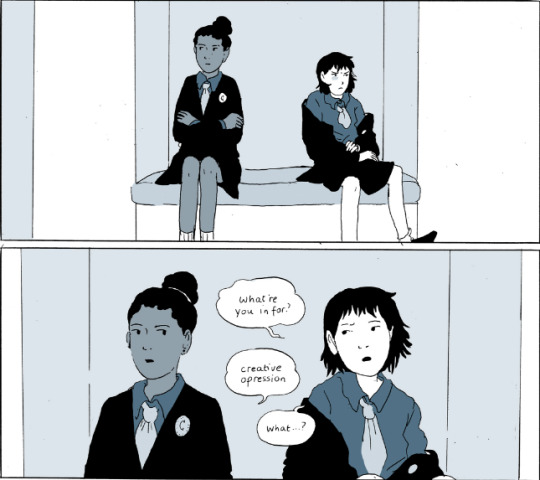
On a Sunbeam is told in two parts. These two threads are interwoven and eventually come together with Mia going to Staircase and finding Grace. The parallels in these two opposing story lines speak to greater critical ideas that exist within queer theory. Although Walden has created a universe where every single person (with the exception of Elliot) identifies as a woman and every known romantic relationship is with another woman, the before and after aspect of queer identity is still present. This way of presenting narrative and the narrative arc itself strays from traditional storytelling, two stories existing, two separate identities the reader gets to know, both existing in tandem. The entire comic ends with Mia’s reconciliation of identities, with finding Grace and looking for some resolution to that chapter of her life. This is a common theme among coded queer fiction, the split identity or the journey from one world to another. When one examines sci-fi fantasy through a queer theory lens this is one of the ways queer themes can exist.
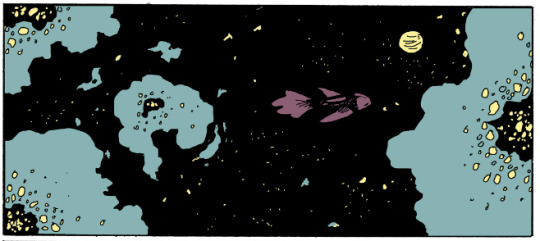
In science fiction the idea of Other is key. In cases involving alien races or new customs, or even futuristic technologies, when creating a fictional Other, that will be rooted in our cultures concept of Other. In this case unlike a lot of science fiction there is no masquerading an unknown entity as an Other, but this concept is now given to us, the reader to process what is like, and unlike our culture now, which is what defines science fiction essentially.
One interesting feature of On a Sunbeam is the fact that it is specifically not diverse. Every character in this webcomic (again barring Elliot who is gender neutral) is assumed to be a woman, and every discussed romantic relationship is gay. This brings in the idea of the reader creating the science fiction, and creating the Other, reconciling differences between our world and the fictional world.
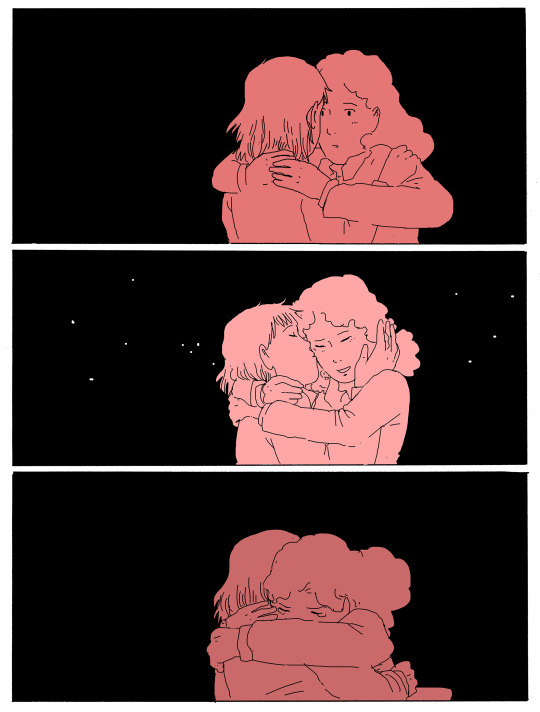
On A Sunbeam is pointedly not inclusive in respects to sexuality and for a reason. Walden’s comic speaks of separatism and the specific catering to a wlw (woman loving woman) audience, a lesbian only piece of media leads to the lesbian Separatist movement that emerged in the 70s, where the idea was to be self-sufficient and independent from a patriarchal society. Lesbian only spaces are a form of resistance against the heterosexual institution.
Through this Walden points out the heteronormativity of media where queerness has to conform to an idea of reality. When consuming media it’s not a surprise to have an all straight cast of characters, it’s not questioned at all. Opposed to when the majority (or even a portion) of the characters are queer it is immediately noticed and the rules of “reality” are applied, whether having that many queer characters is realistic, especially in a narrative that is not a typical gay narrative. It is rare to find media where every character is queer opposed to finding a mass amount of media where every single character is straight. Side note if I have to hear that the diversity of a piece of media is just trying to reflect the world's demographic then clearly I’m missing the statistic that said that most of the world is white, everyone is gorgeous, and vampires and werewolves are better represented than trans people. GLAAD’s 2016 report of LGBTQ representation sits at 4.8% of characters on primetime television which is 43 characters out of 897. So my point here is that we can have this enormous mass of straight characters and not question it which is a direct result of heteronormativity. Only having wlw characters is a direct challenge of the heteronormative structure of the media we consume, and by doing this Walden asks readers to acknowledge this, the immediate discomfort with the unexplained fact that every single known character in her comic is a wlw and consider it rationally.

Why are queer identities a feature of science fiction? Why is one of the things that is striking not the fact that there are space ships that are giant robotic fish, or that there is a place called The goddamn Staircase which has glowing giant fox beasts in it. Where does the true other lay? Not in the world we live in entirely, but where we see ourselves fit in. Ain’t that poignant enough for y’all.
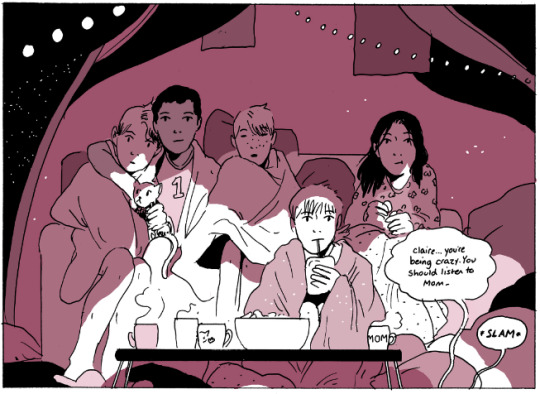
Last point my man. The theme of family and community is prevalent in queer media too because so much of queer identity (or at least what media leads us to believe) is about acceptance. Acceptance into the community around (be it the general community or the LGBT one), acceptance into ones family, or acceptance into the greater world. Found family comes into play in many queer stories in opposition to biological family, “The blood of the covenant is thicker than the water of the womb” maybe?
The dynamic between Mia and the team on the ship and Grace and her family demonstrates this concept pretty accurately. This plays into the idea of building a community which can be more supportive and healthy than the community one is born into. This is really part of the queer identity because unlike some other intersecting identities as a queer individual you aren’t typically born into a queer community, you go and seek out one, or build one yourself. Part of being queer is trying to find other people who are queer and building a network of individuals who aren’t necessarily blood related but feel like family. This also can be coupled with the rejection of the patriarchal structure of the nuclear family, which plays directly into queer identity, which is inherently aberrant and maladjusted to fit into the heteronormative idea of it. The whole story, of two wlw girls who meet when they are separated from their families, in an institution which they both don’t fit into and get into trouble because they can’t conform and find companionship because of their isolation and dissatisfaction speaks to the reality of living as a queer woman.
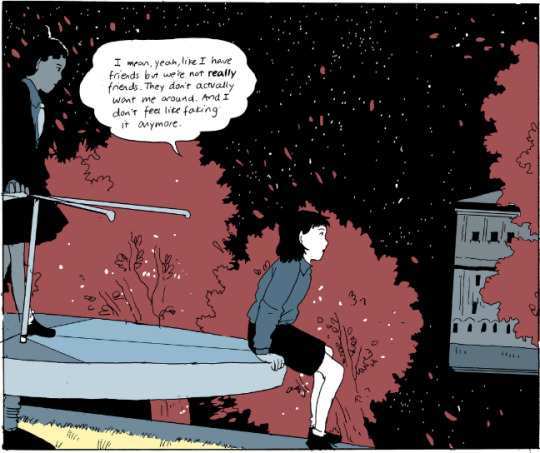
Anyways that’s my analysis! On a Sunbeam is written by Tillie Walden who is is super bomb and very great for letting me use these images
0 notes
Photo

Aveux non Avenus, Planche III, Montage by Claude Cahun, 1929-30
339 notes
·
View notes
Photo

audre lorde, from letter for jan, the black unicorn
644 notes
·
View notes
Text
Responce to “Diving into the Wreck”
(Otherwise known as How This Book Made Me Cry Twice)
When it comes to poetry, good poetry at least, I have a definite soft spot, and Adrienne Rich’s Diving into the Wreck is to me a perfect example of everything gold and glowing about poetry. It is prompting, honest, universal and beautiful.
I loved it, can you tell?
The first section of the book, seemed to contain poems unified by a theme of waking up, becoming cognisant of one’s self. It’s cold sentiments of starting anew, trying times, are warmed by comradery. If this represents the “coming out” or “becoming aware” aspect of queer stories, which so often over saturate media’s depiction of the lgbt experience, it is shown in an honest and gentle way. So often in lgbt stories a queer person realizes their sexual identity and then that’s it, the tale is over. Here however, illustrated by “Waking in the Dark, “Incipience”, and “When We Dead Awaken” amongst others, it’s a natural occurrence, moved through, move on. She becomes cognisant and then remains present.
The second section, for me, brought an aspect of universality, not normative topics but written in such a way that even so they read like life, like everyone’s life wrought with emotion and coloured by relationships that please and distress. As a reader who identifies with the author’s experience however, this section was close to my heart, in the way that poetry can be, specifically. It proved our thoughts, tucked secretly away in our heads, are often echoes by our peers, and we can be unified if only we can convey them.
Section three tackles feminism, somewhat more predominantly than the previous two. Here Rich speaks of a world “masculinity made unfit for women or men,” and later of cloth “ironed by a woman with aching legs.” She speaks of dissatisfaction in the relationship dynamics at play in the model family, about toxic masculinity and rape culture, the dangers of being an outspoken woman. Most easily related to us all, she writes of the challenges of loving someone. In “For the Dead”, Rich writes lines that unify, words true not just of gay relationships or straight relationships, but dealing simply with the trials of loving someone at all. “I dreamed I called you on the telephone/ to say: Be kinder to yourself/ but you were sick and would not answer/ the waste of my love goes on this way/ trying to save you from yourself/ I have always wondered about the leftover/ energy, water rushing down a hill/ long after the rains have stopped.”
The fourth and final section finishes strong and suddenly. “Why are men afraid/ why do you pity yourselves/ why do the administrators/ lack solicitude, the government/ refuse protection.” She ends the text with a single word, but one that well sums it: “why.”
The reality of what it is to be a woman, what it is to be gay, a feminist, an activist, is all explored here, layed out in front of us so naturally and gracefully it honours and validates these identities. W.S. Merwin wrote about Rich “All her life she has been in love with the hope of telling utter truth, and her command of language from the first has been startlingly powerful.” I’ve heard it said that good poetry is truth, and it think perhaps Rich hits truth on the nail so hard it rings universal.
0 notes
Photo

Julie Mehretu (Ethiopian/American, b. 1970), Mind Breath Drawings, 2010. Graphite on paper, 62.8 x 90.3 cm.
169 notes
·
View notes
Photo


Eyre De Lanux, 1933
photos by Carl Van Vechten
37 notes
·
View notes
Audio
In My Mind - Amanda Palmer Life is Strange
1K notes
·
View notes
Quote
—And there was no dance, no holy place from which we were absent.
Sappho, excerpt of Fragment 19 (tr. by Julia Dubnoff)
6K notes
·
View notes
Text
Diving into the Wreck
The text I chose to read and analyse was Adrienne Rich’s Diving into the Wreck, a book of poetry spanning 1971-1972. Rich, the author of this text, was an influential American poet and feminist, who spoke out about the lgbt experience, amongst other topics of political activism. This collection of poems is known to be one of her most volatile and exploratory works, a winner of the 1974 National Book Award which she shared with her contemporaries, Audre Lorde and Alice Walker.
As is the nature of poetry, interpretation often varies, but I found the work to focus mainly on relationships and oppression, as general themes. Rich’s strong voice, battered and bitter, here attempts to battle heteronormativity and places heavy blame upon her oppressors (she names a few), while maintaining a light poetic hand. Heart-felt, honest and sometimes divisive prose, garnished with lovely imagery, this short compilation of poetry presents strong opinions on the reality of activism and patriarchy, and depicts relationships as they are; strange and wonderful.
Adrienne Rich’s voice as a writer and activist, would be considered “othered,” both in that she focuses on lgbt topics, amongst other topics deemed political or polarizing, and in that she herself is a member of the lgbt community. Rich is one of the more notable poets on the subject, award winning multiple times over and well known as a staple of feminist reading. She is also one of the better known modern writers/activists to represent the gay community.
2 notes
·
View notes
Photo
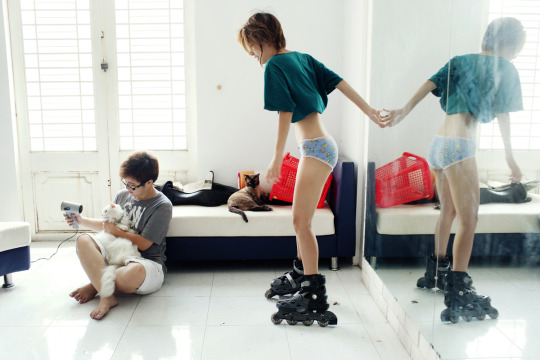


from the photography project The Pink Choice by vietnamese photographer Maika Elan Nguyen Thanh Hai (Maika Elan) was born in Hanoi, Vietnam, in 1986. In 2010, Maika moved to documentary photography and her first project, The Pink Choice, focuses on the personal lives of gay couples in Vietnam.
38K notes
·
View notes
Photo

♡♡ mine
please don’t remove caption or self promote
55 notes
·
View notes




